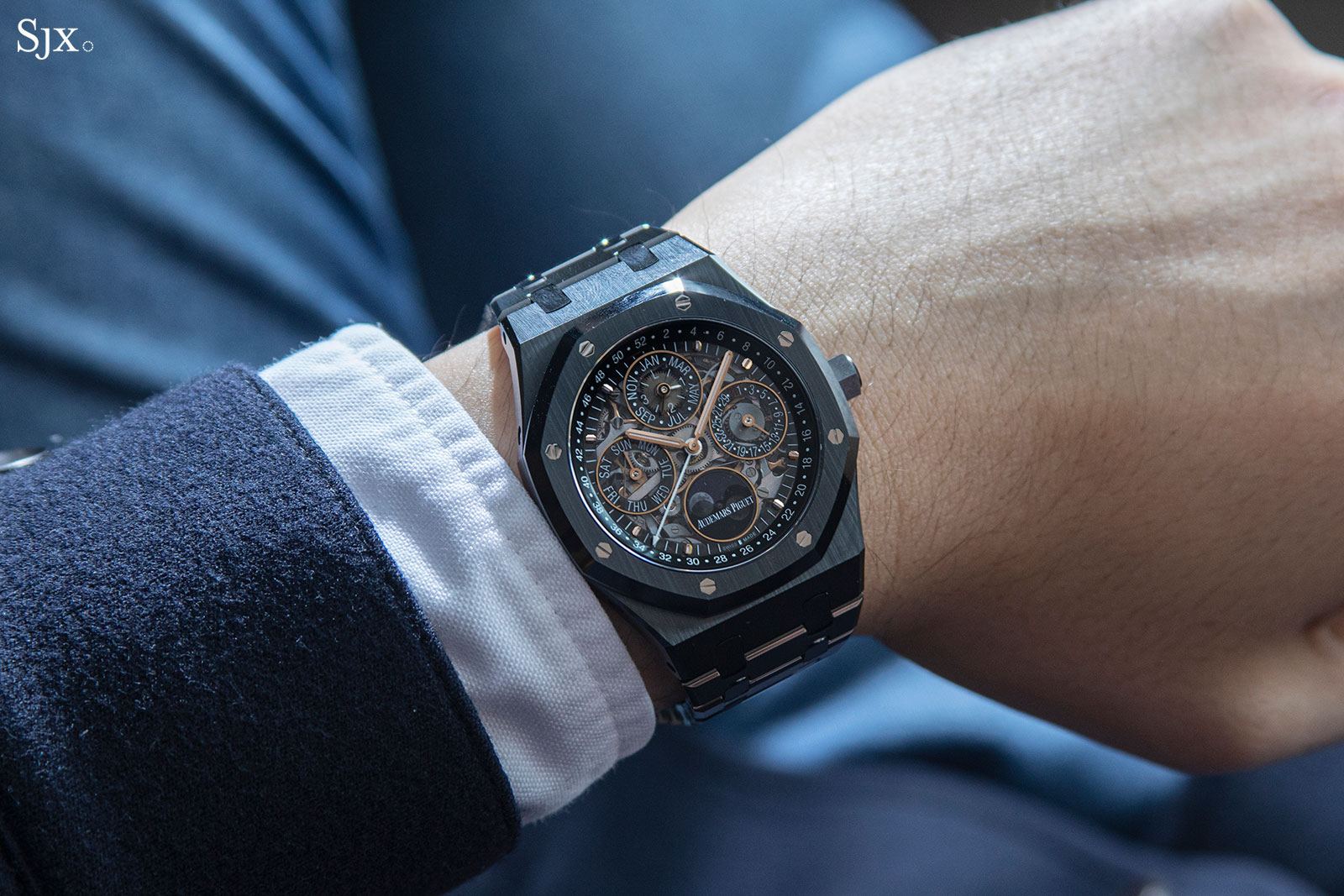Up Close: Audemars Piguet Royal Oak Perpetual Calendar Openworked in Black Ceramic
Yes, of course.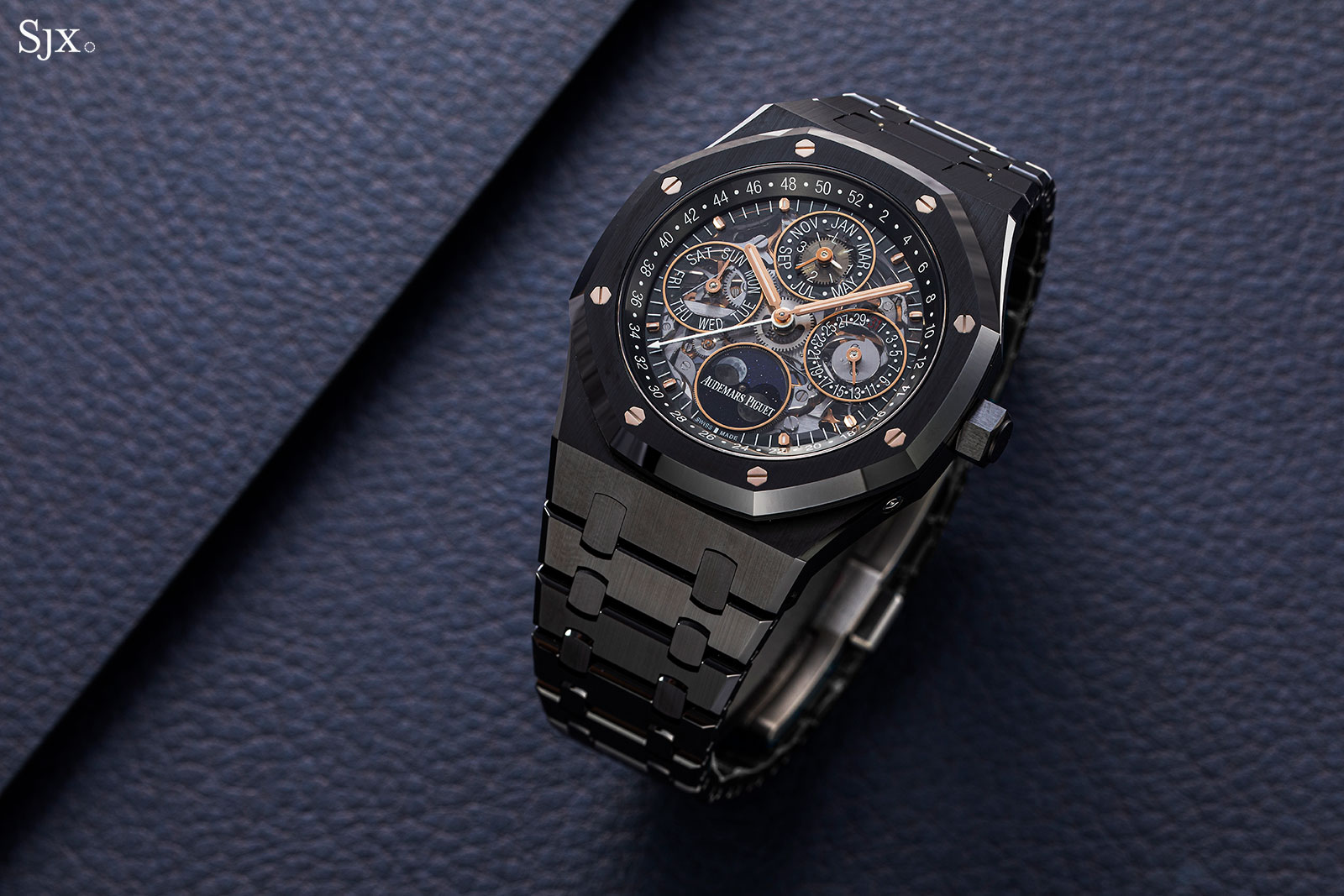
The last time Audemars Piguet had a skeletonised Royal Oak perpetual calendar in the catalogue, it was 2015. The skeleton perpetual is familiar enough that it doesn’t seem to have been missing for that long, but it’s been a half-decade.
In the mean time, Audemars Piguet (AP) unveiled the next generation of Royal Oak Perpetual Calendar, with the case widened to 41mm, and then introduced it in black ceramic, and only just, in white ceramic. And it took some time to develop the thinnest automatic perpetual calendar ever.
But now the Royal Oak Perpetual Calendar Openworked is back, in proper, fine form.
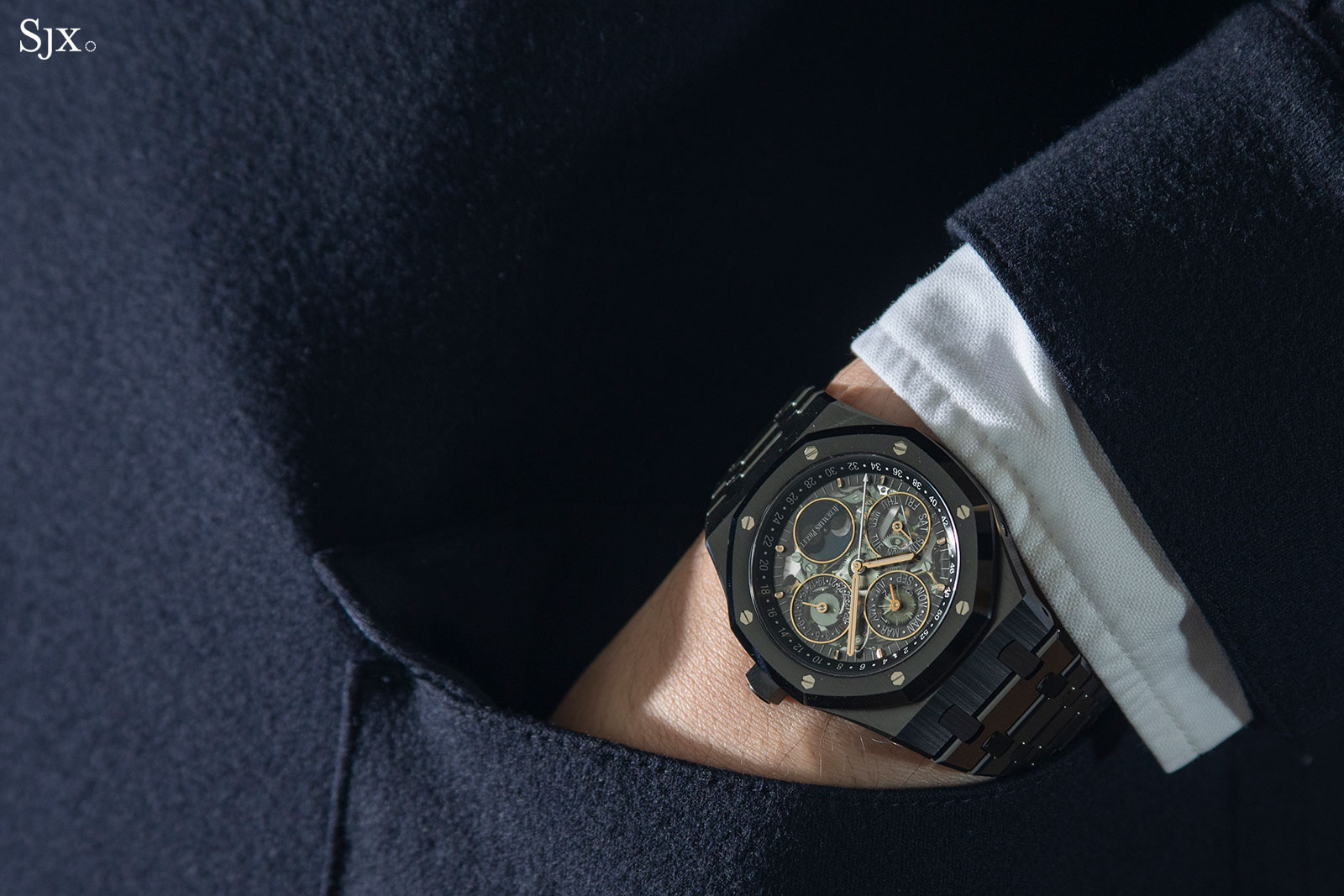
Putting a skeleton movement inside the bestselling Royal Oak in black ceramic is obvious, and could have been done in the easiest way possible. But AP went one better; it developed a new calibre, the 5135, that is not merely open-worked, but also redesigned for maximum aesthetic effect.
“This is the first time in many years that AP has introduced an openworked perpetual calendar wristwatch,” says Michael Friedman, the head of complications at AP, “The effort here was to create an experience of contrast and play of light.” I’d say AP succeeded.
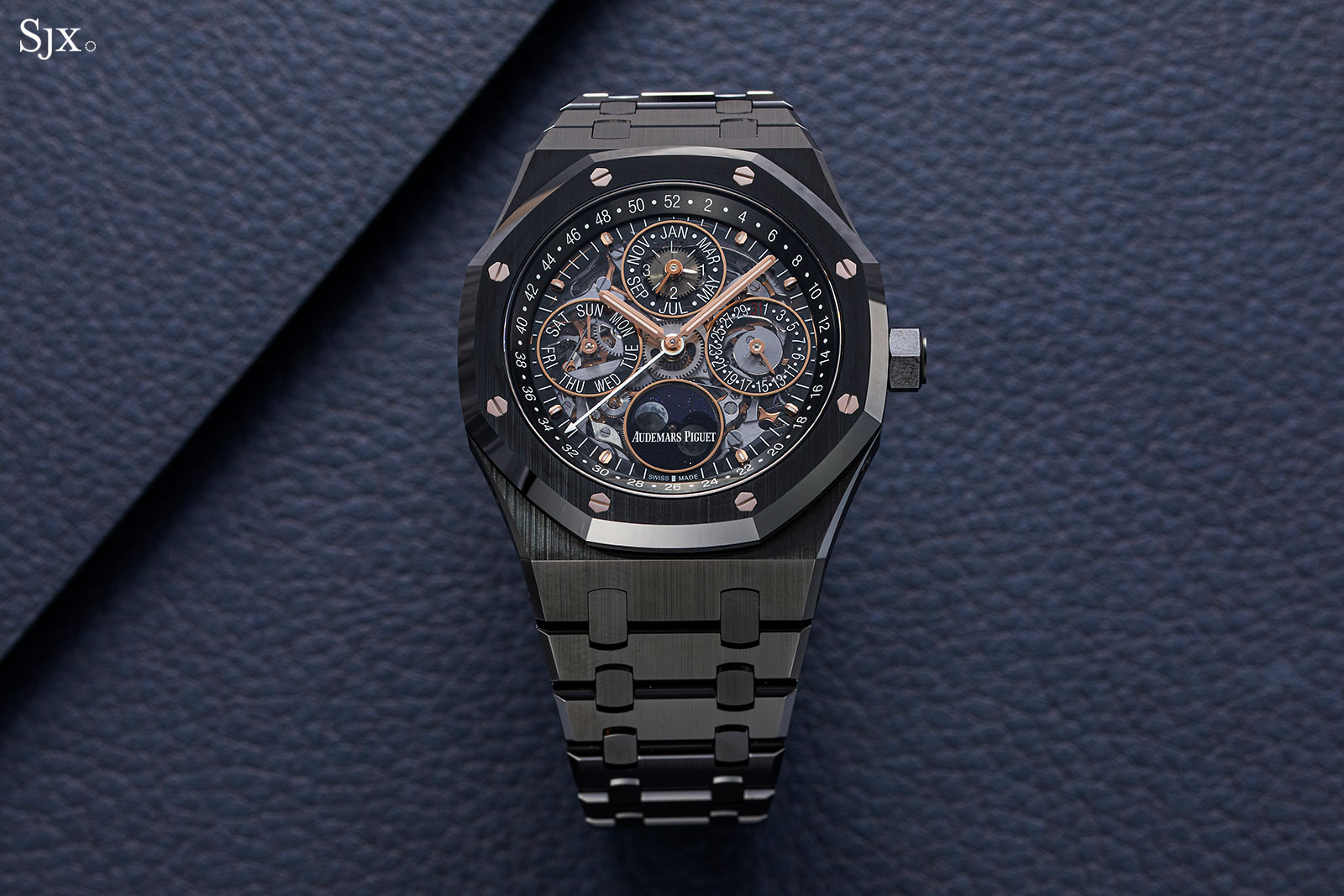
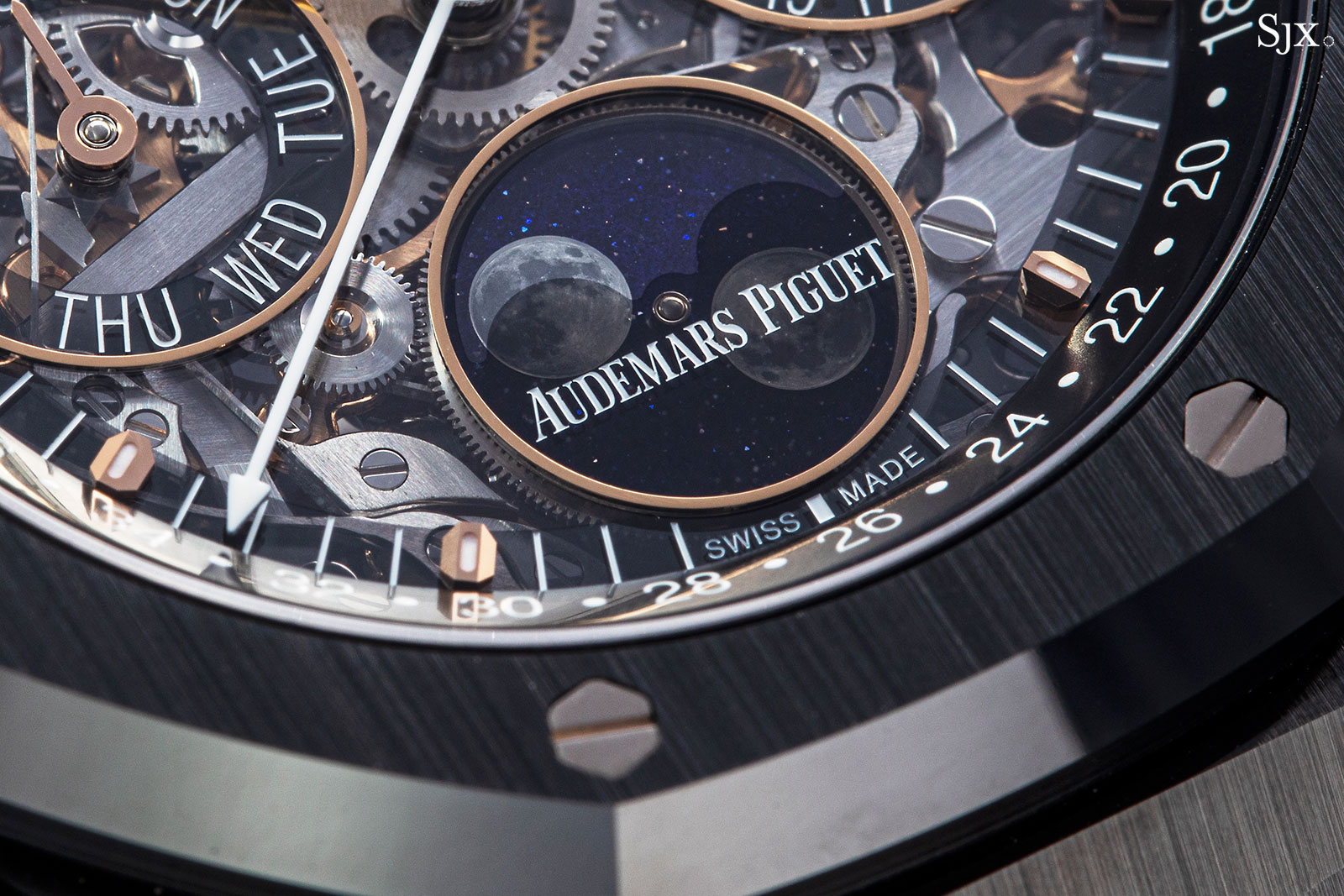
The watch pictured is a travelling prototype, so pardon the cleanliness of the movement
Ceramic and the Royal Oak
But first, a small, modestly technical digression on the material and the watch. The case and bracelet are made of black ceramic, specifically zirconium oxide stabilised with yttrium oxide – essential for the case finish required for the Royal Oak.
Ceramic parts are usually made via injection moulding or sintering. The latter process uses heat and pressure to compress ceramic powder into a solid mass; the nature of the process means the resulting shape is dense, a useful property for the case and bracelet parts. Adding yttrium oxide further increases the density, raising the hardness of the ceramic, which “provides the canvas for the hand-finishers” as Mr Friedman puts it.
The high level of hardness is crucial for the Royal Oak in order to achieve the extreme and exceptional degree of surface finishing – the surface needs to be hard enough to withstanding the polishing and then retain the finish – which is almost equivalent to the treatment done to gold or steel Royal Oaks, even though gold and steel are softer and easier to work.
As a result, the Royal Oak has the most refined surface finishing across all ceramic watches. The contrasting and alternating polished and brushed surfaces are absolute and impeccable.
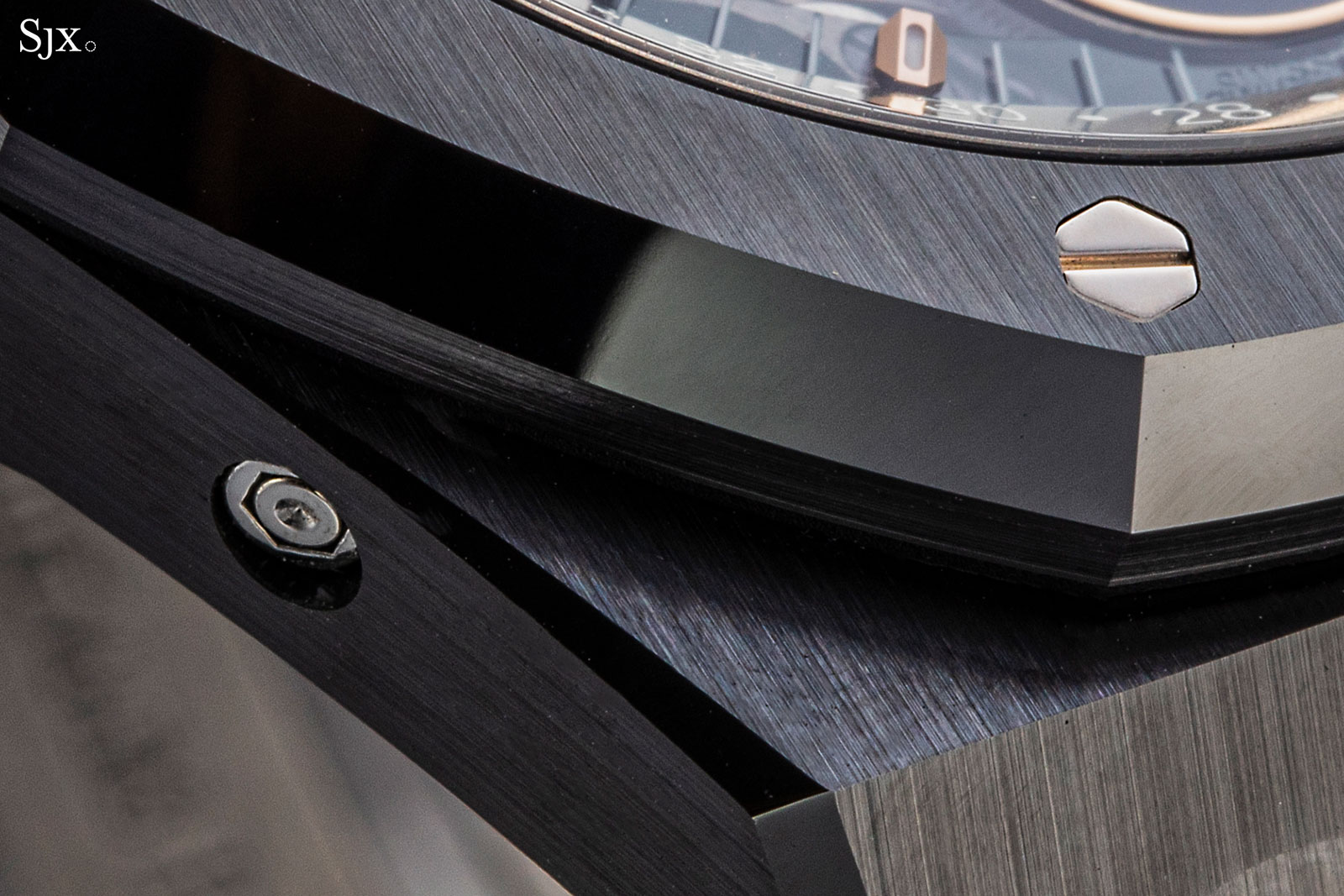
The sharpness of the edges on the case and bezel are just remarkable
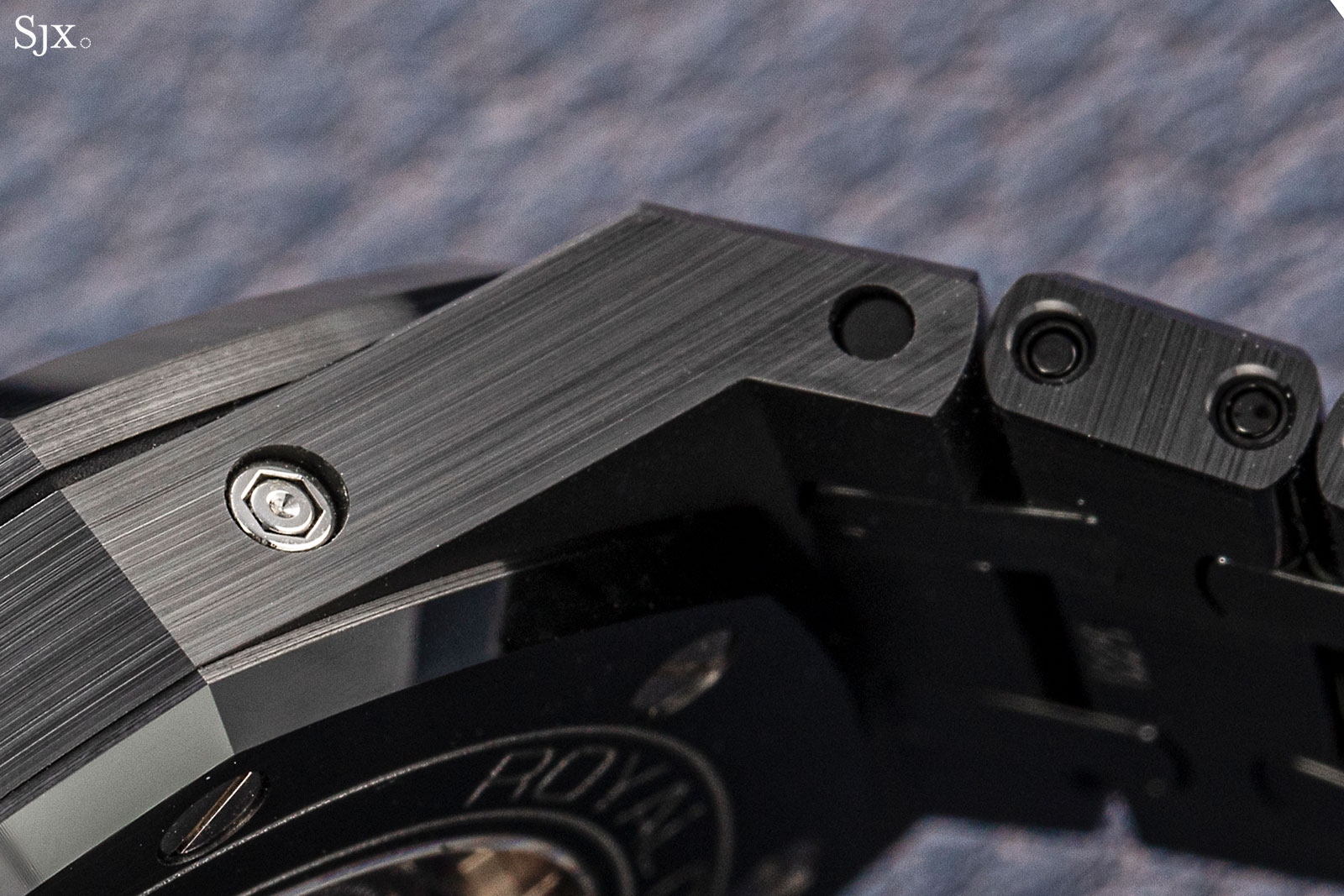
A downside of the hardness of ceramic is the fact that it is also brittle, so it cannot withstanding torsional, or twisting, forces. So most ceramic watch cases rely on an metal inner case, secured to the ceramic outer case with adhesive, to contain the movement, with the metal case back then screwed into the metal inner case.
The genius of Gerald Genta’s construction of the Royal Oak – originally devised to make it water-resistant but also extra-thin – was to hold the back and bezel together with screws spanning the height of the case, which actually makes the Royal Oak construction ideal for ceramic.
There’s no inner metal case required in the Royal Oak, instead the gold screws in the titanium case back tighten into the white gold nuts on the bezel, as is convention for the Royal Oak. The result is a sandwich of sorts, with the bezel and back held together by screws, with the case band in between. And the back is titanium, instead of ceramic, to avoid cracking it if the rear screws are excessively tightened.
But in the bracelet, the properties of ceramic are unavoidable, so unlike conventional Royal Oak bracelets that have screw bars to hold each link, the ceramic bracelet links here are secured by friction-fit steel pins inside steel tubes within each link. Sizing the bracelet, as a result, is a delicate operation as each pin has to be pressed out of the link with enough force to remove it, but gently enough that the ceramic link is not cracked or chipped.
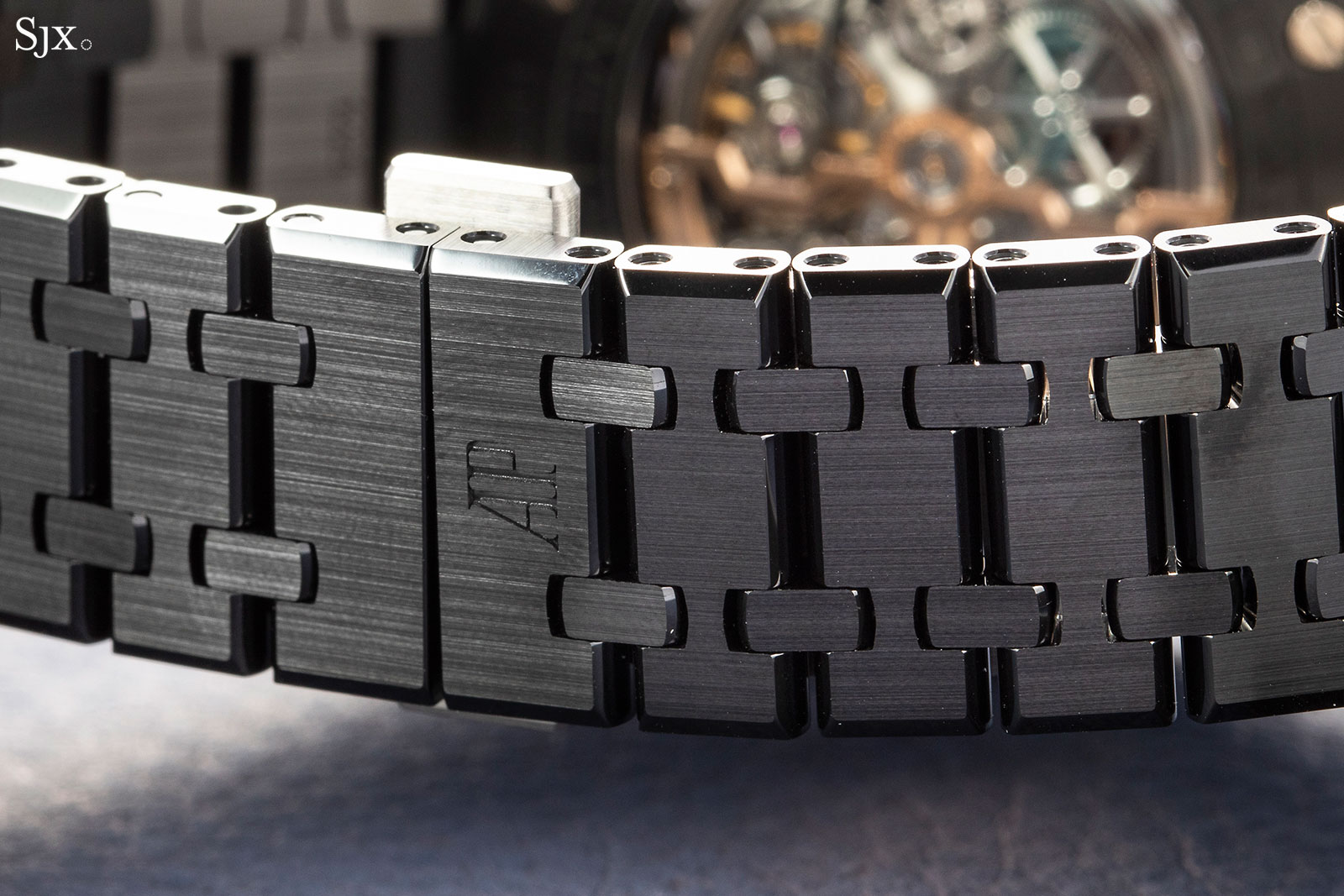
Notice the polished finish on the inner surfaces of the inside links
Skeleton and rosy
Since the watch is skeletonised, the aesthetics and movement are one and the same – excellent.
The cal. 5135 inside is derived from the cal. 5134 found in the standard perpetual calendar models, and is functionally identical. But the cal. 5135 has been extensively open-worked on the front and back, revealing the density of the mechanics inside the movement.
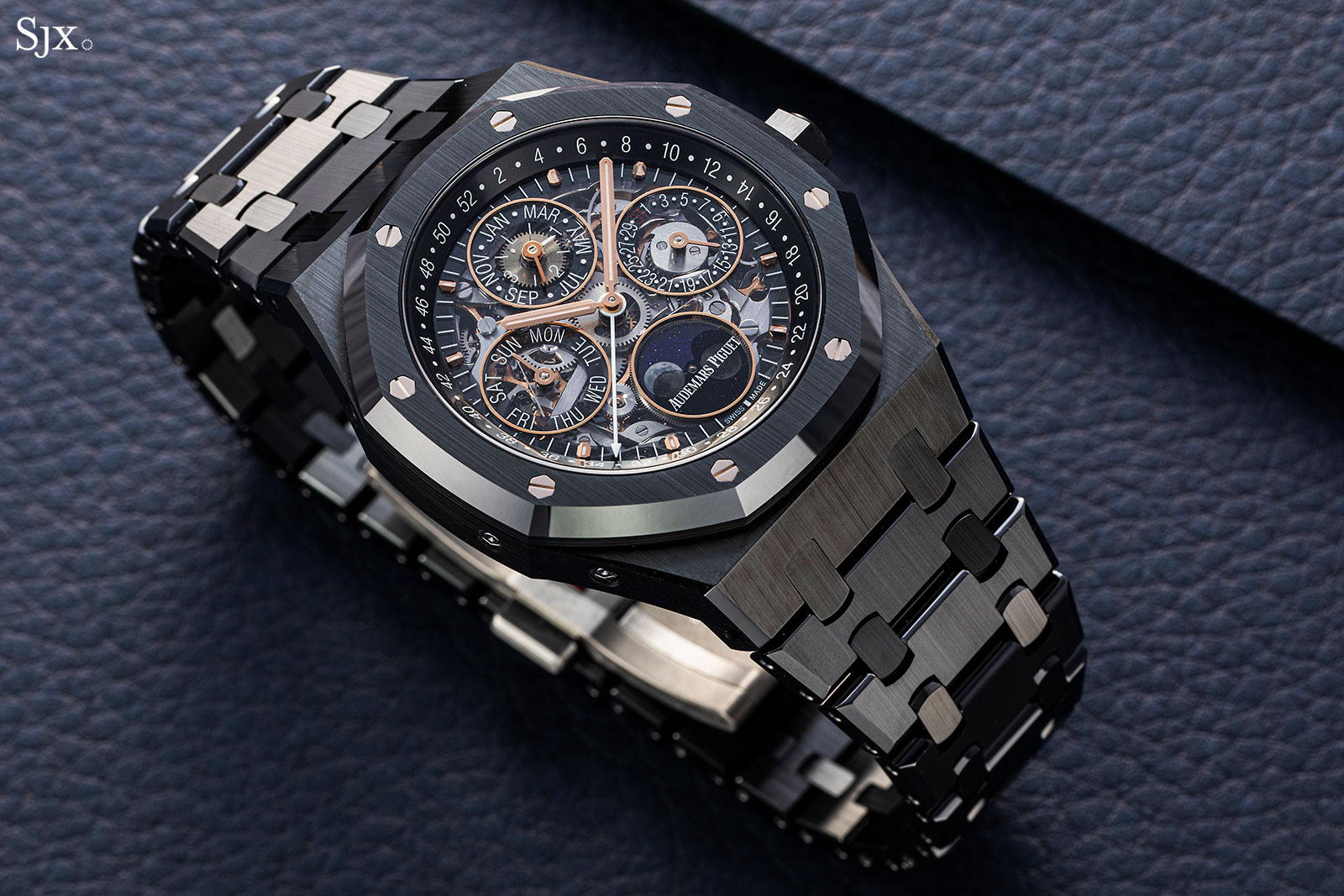
Both the hands and applied hour markers are solid pink gold, and importantly, the movement has been dressed up to match.
The plate of the perpetual mechanism is skeletonised but also gilded in pink gold, leaving scattered traces of the rose alloy across the dial – arguably the most important aesthetic detail on the front. The liberal use of small but pronounced rose gold elements on the front gives the watch a rich, lively feel that’s very different from the monochromatic style of the solid-dial Royal Oak in black ceramic.
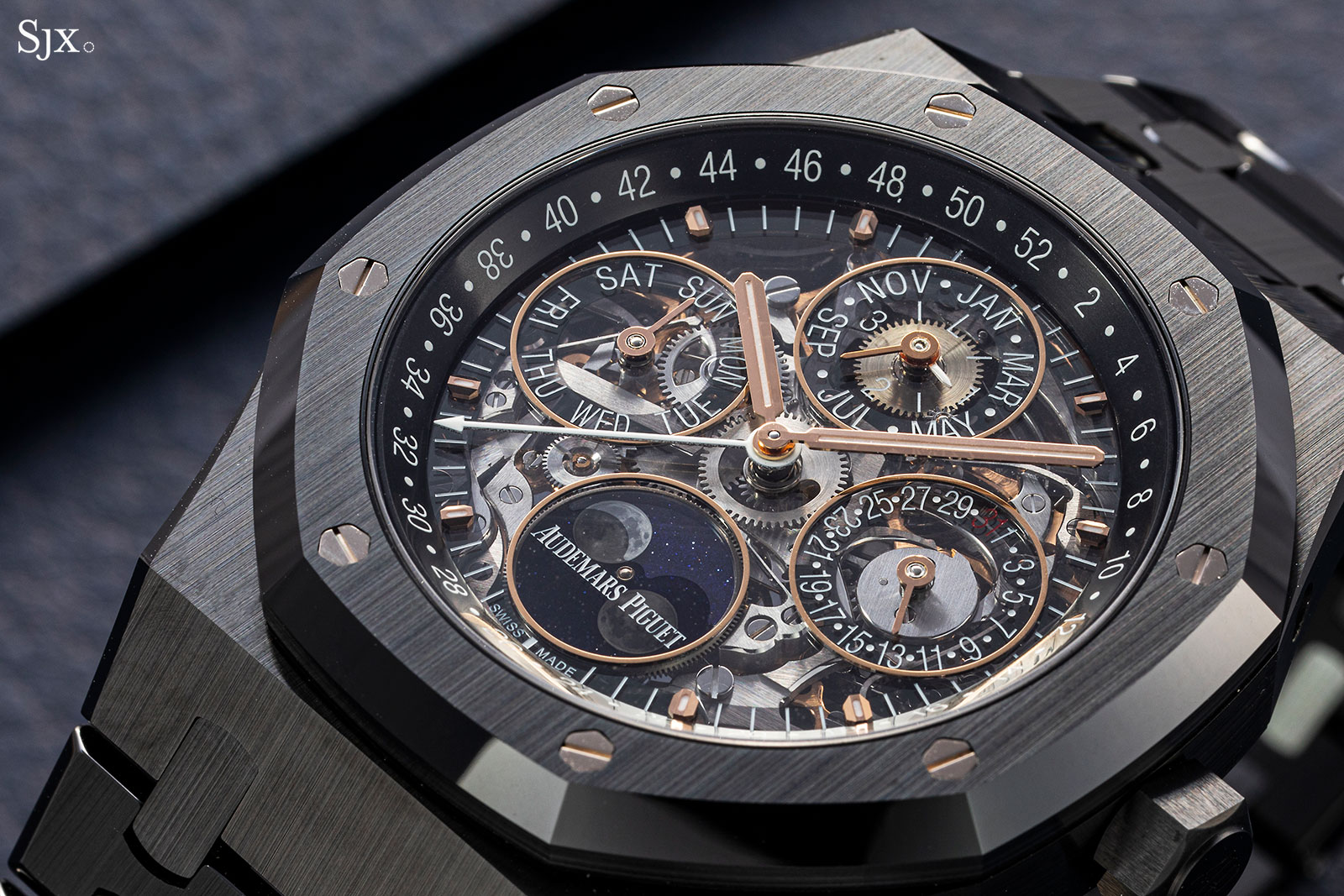
The face is striking and attractive at arm’s length, but also up close. Although AP has long moved away from the flowery engraving favoured in the 1980s and 1990s for skeleton watches – the style now is dark in colour and geometric in shape – the movement is still finished as well as it can be. The levers, springs, wheels and cams on the visible on the dial are all grained, chamfered and polished as necessary.
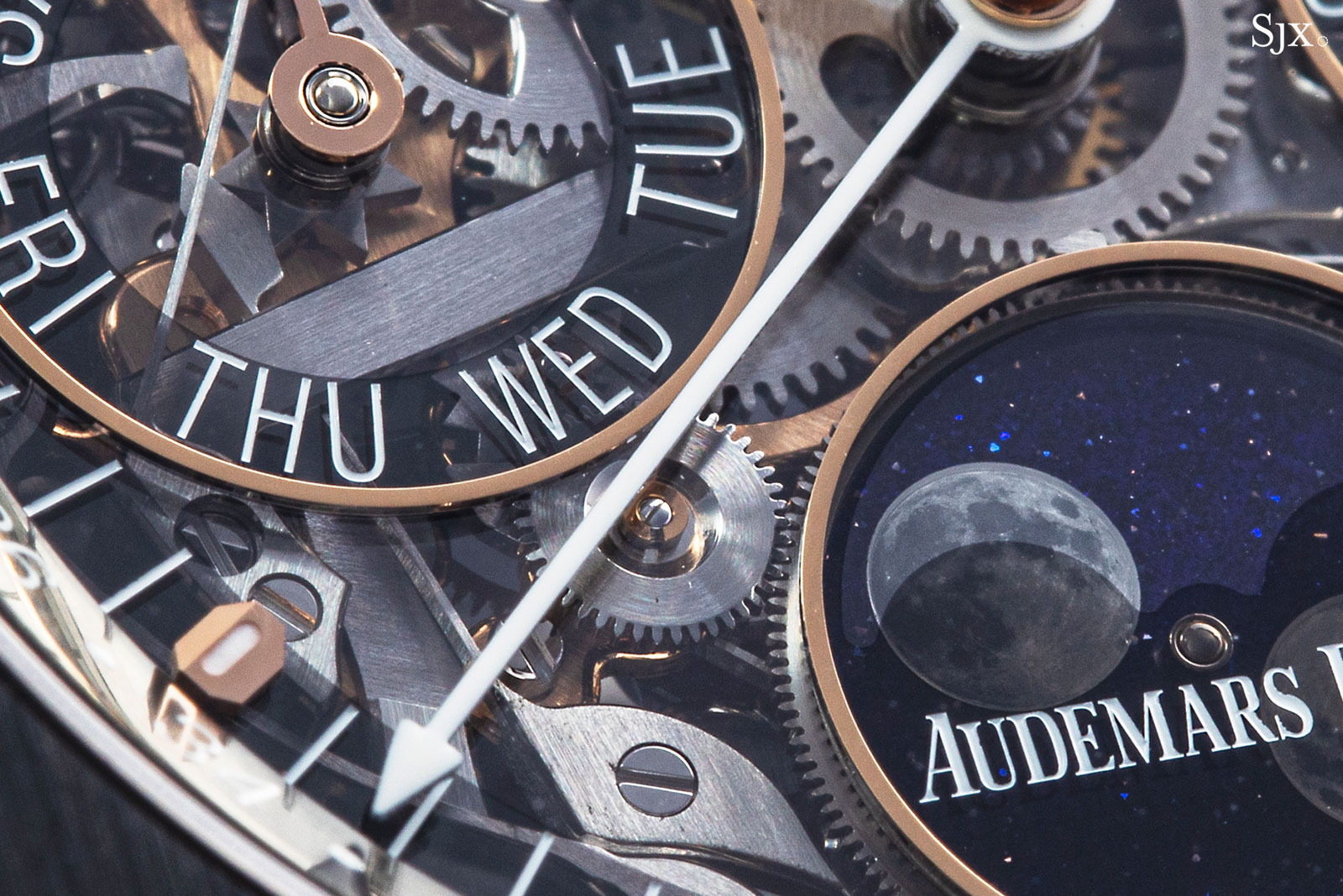
Beyond the movement finishing in front, there are other minute details to admire.
There isn’t much of a dial to speak of, instead there are several smoked sapphire chapter rings for the minute track and individual calendar sub-dials. All the dial markings are precisely engraved on the sapphire chapter rings, and then filled with white lacquer, making legibility good, although the typography is necessarily small.
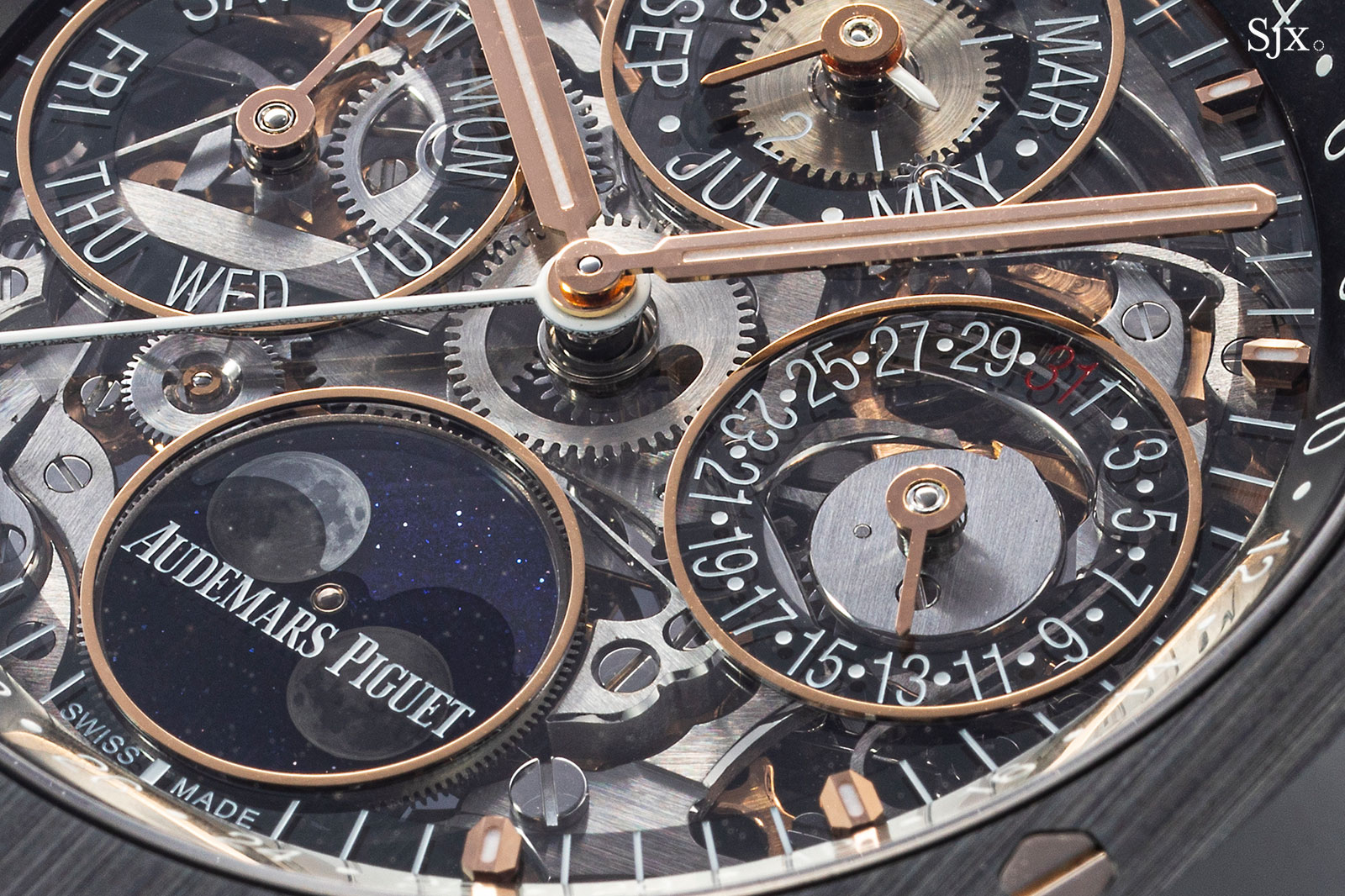
And the moon phase disc is sparkly aventurine, carrying a photorealistic reproduction of the moon – this gives the highly technical dial a little romantic flourish.
If I had to change one thing about the dial, it would be the typography for the calendar indications, which is now a sans serif font that is unquestionably functional but plain and unimaginative.
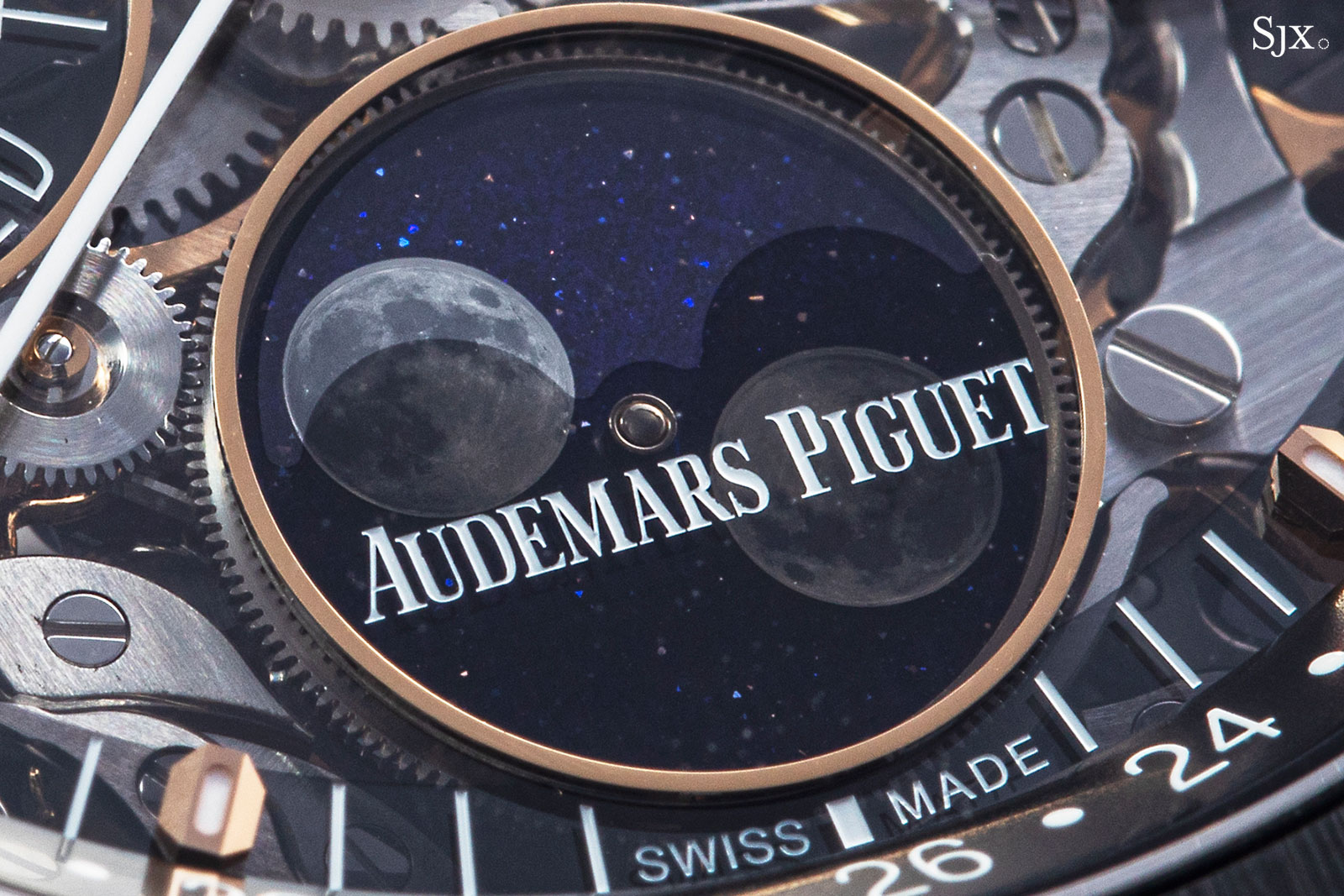
Octagonal and sharp
Yttrium stabilised or not, the case is a work of art in itself. The surfaces, edges and shapes are gorgeous and gorgeously finished.
The only shortcoming, and this is nitpicking, are the unavoidable recesses on the case flanks for the perpetual calendar correctors. A redesigned perpetual calendar mechanism that relies solely on crown adjustment would get rid of the correctors, but that’s something that will probably have to wait until the next generation of perpetual calendars. And another upside of ridding the case of correctors would be to increase its water-resistance from the current 20m.
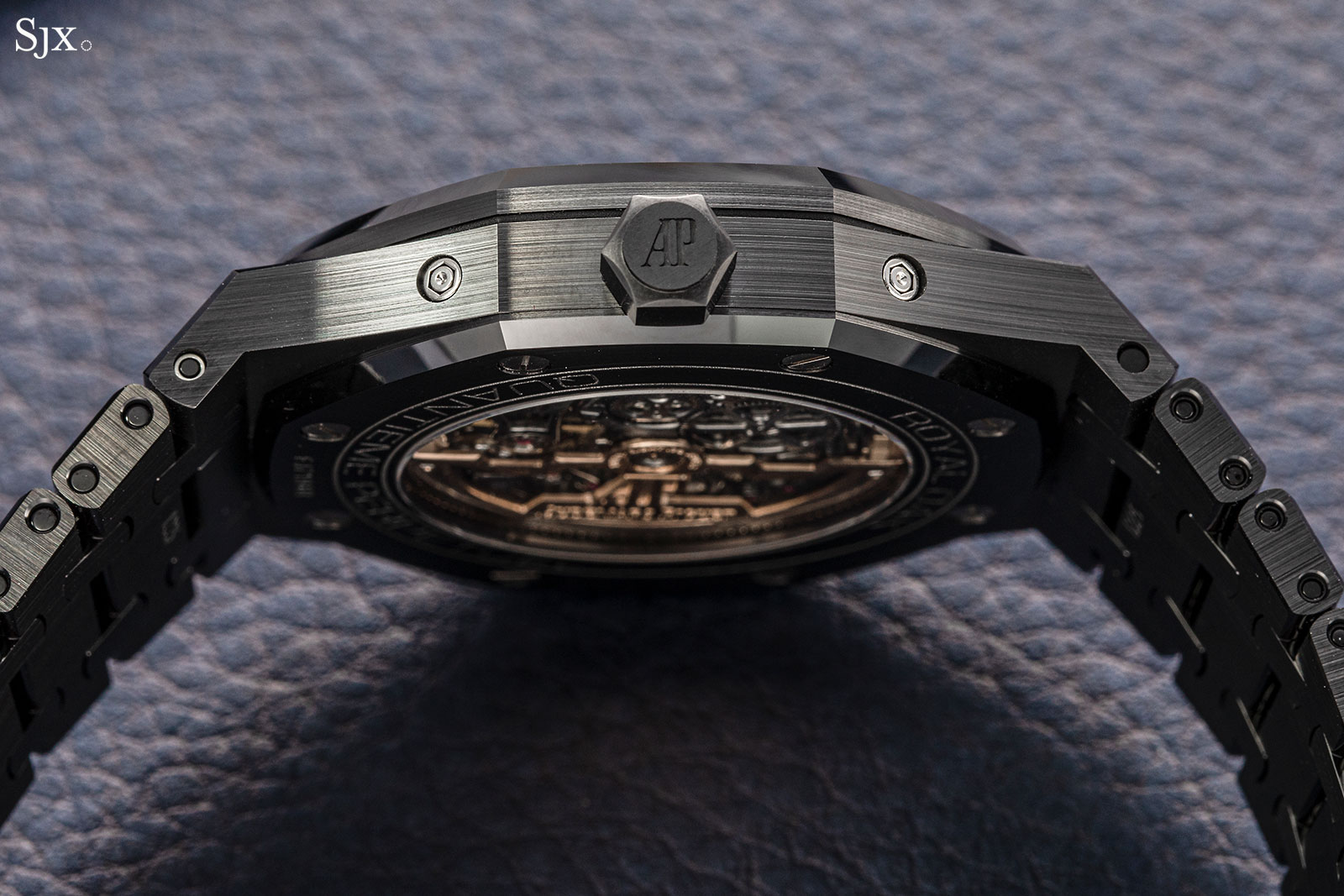
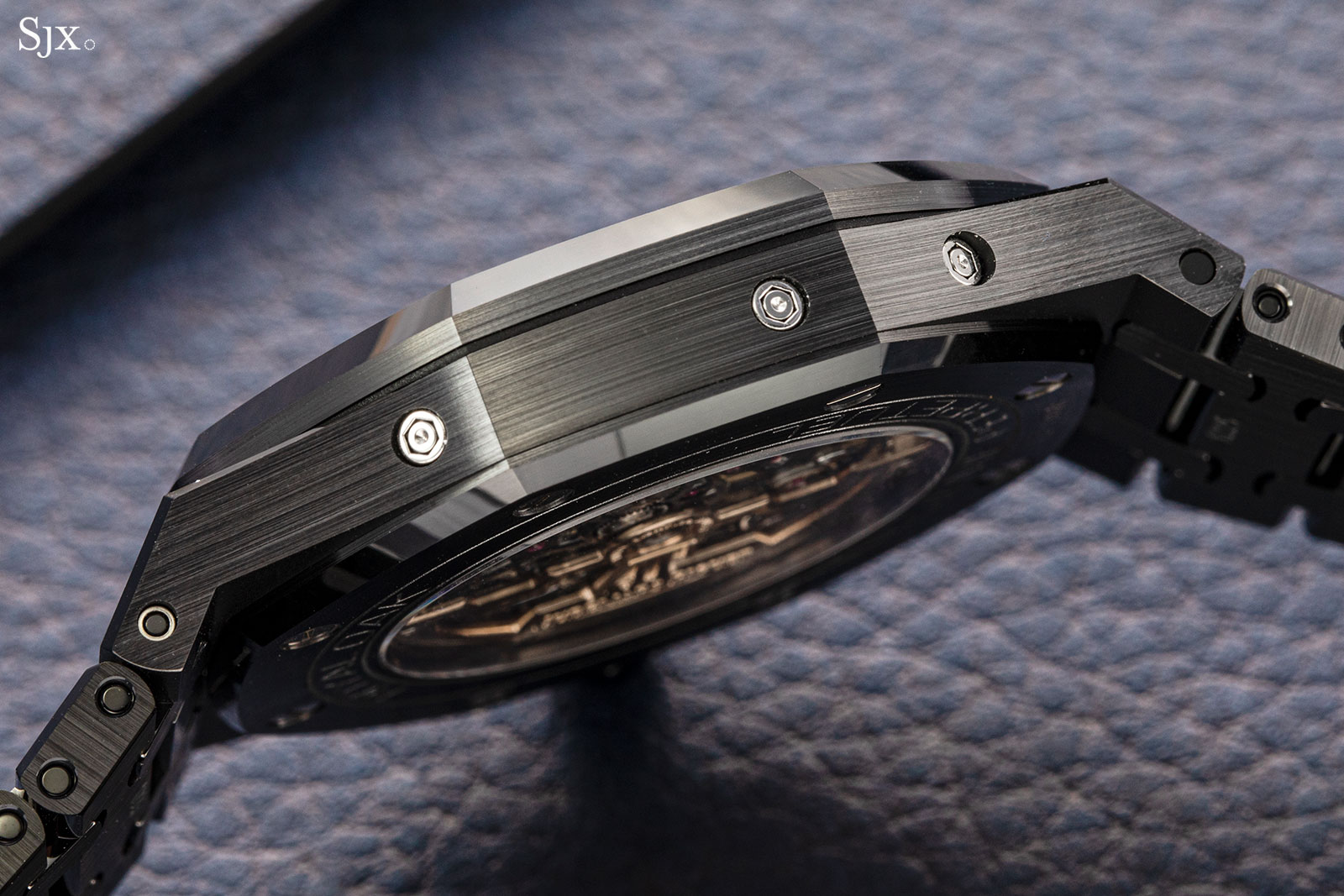
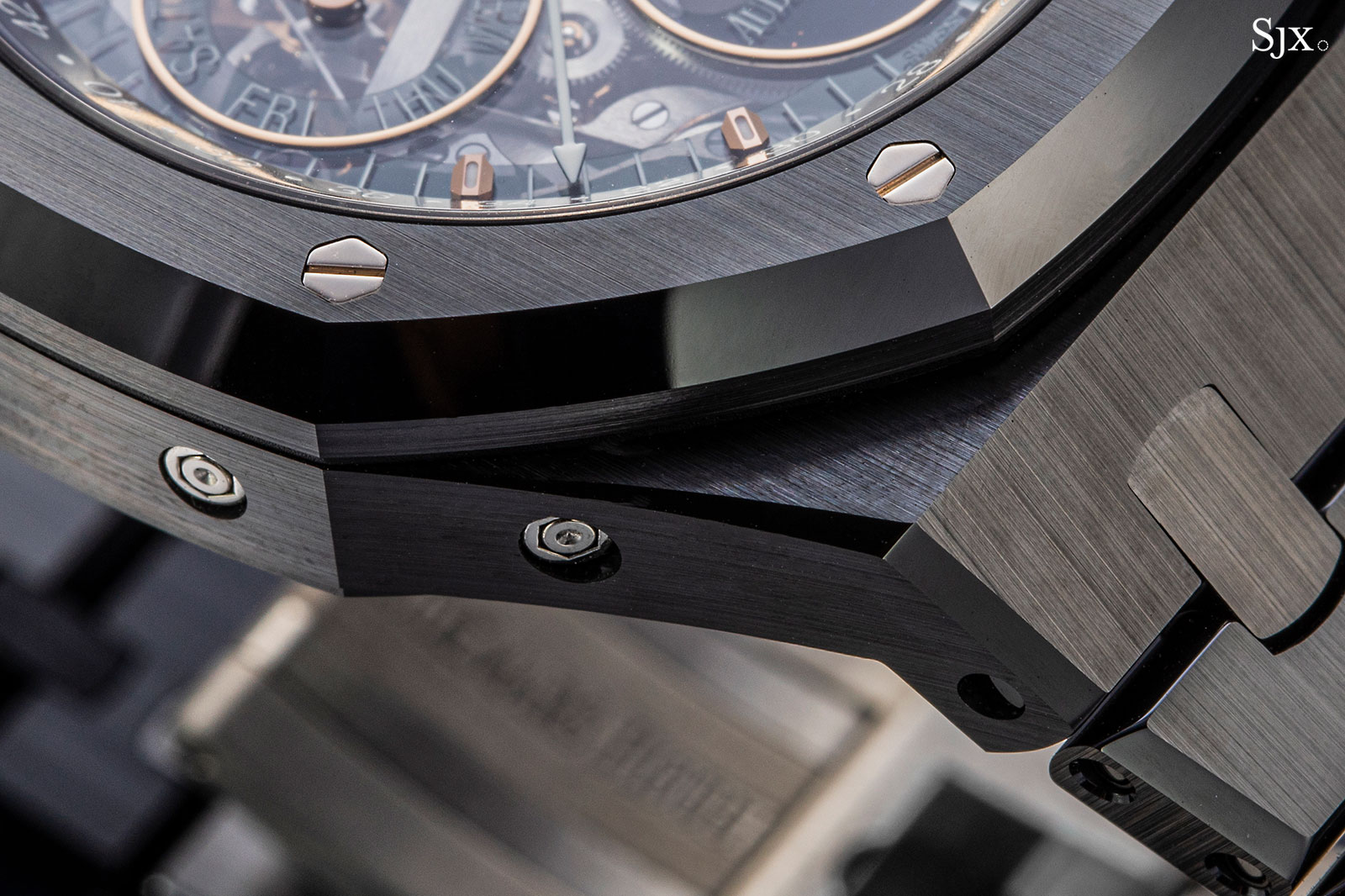
The movement
The cal. 5135 is descended from the movement found in the extra-thin movement found in the seminal perpetual calendar of 1978, a watch which, according to AP museum curator Sebastian Vivas, helped saved AP during the Quartz Crisis by becoming a bestseller, so much so that AP was making some 400 a year at the peak.
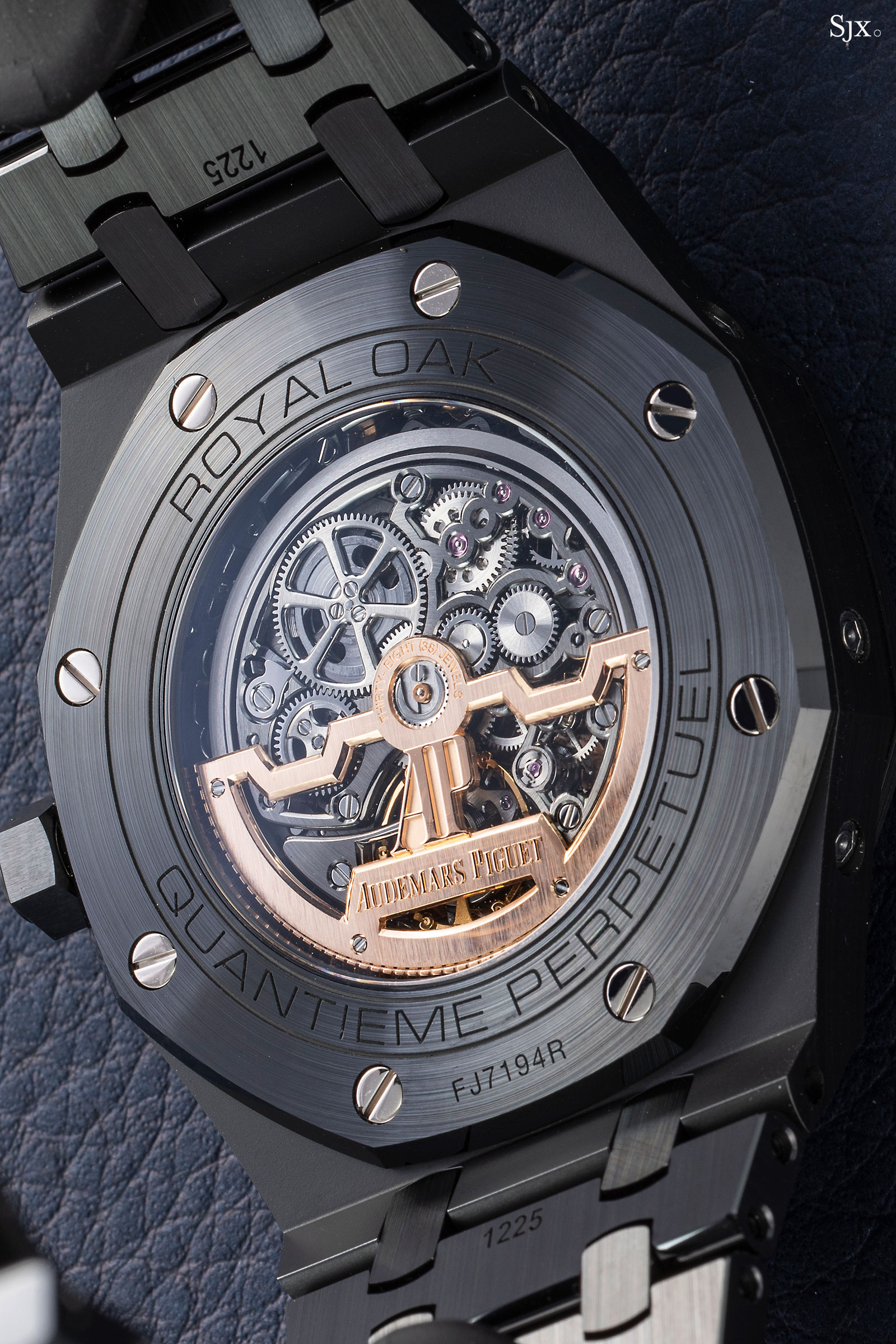
In other words, the movement has been around a long time. The base movement is the cal. 2120/2121, descended from the Jaeger-LeCoultre cal. 920 that made its debut in 1967. Now the movement is produced in-house by AP, which got the rights when it sold its minority stake in Jaeger-LeCoultre (JLC) to Richemont in 2000. Today Vacheron Constantin is the only other company using the movement, mostly in the Overseas Ultra-Thin models.
The primary downsides of the movement’s lengthy history are the short power reserve of 40 hours or so, and the fussy calendar adjustment. Despite its age, the movement is a beauty, and here the beauty has been accentuated by artful skeletonisation and finishing.
Top surfaces of the bridges are straight grained, in keeping with the clean skeletonisation, but all bevels are wide, rounded and mirror polished, with some including sharp inward corners, indicating they have been refined by hand.

The barrel bridge is particularly beautiful in form and finish, including several sharp inward corners on its scalloped inner edges.
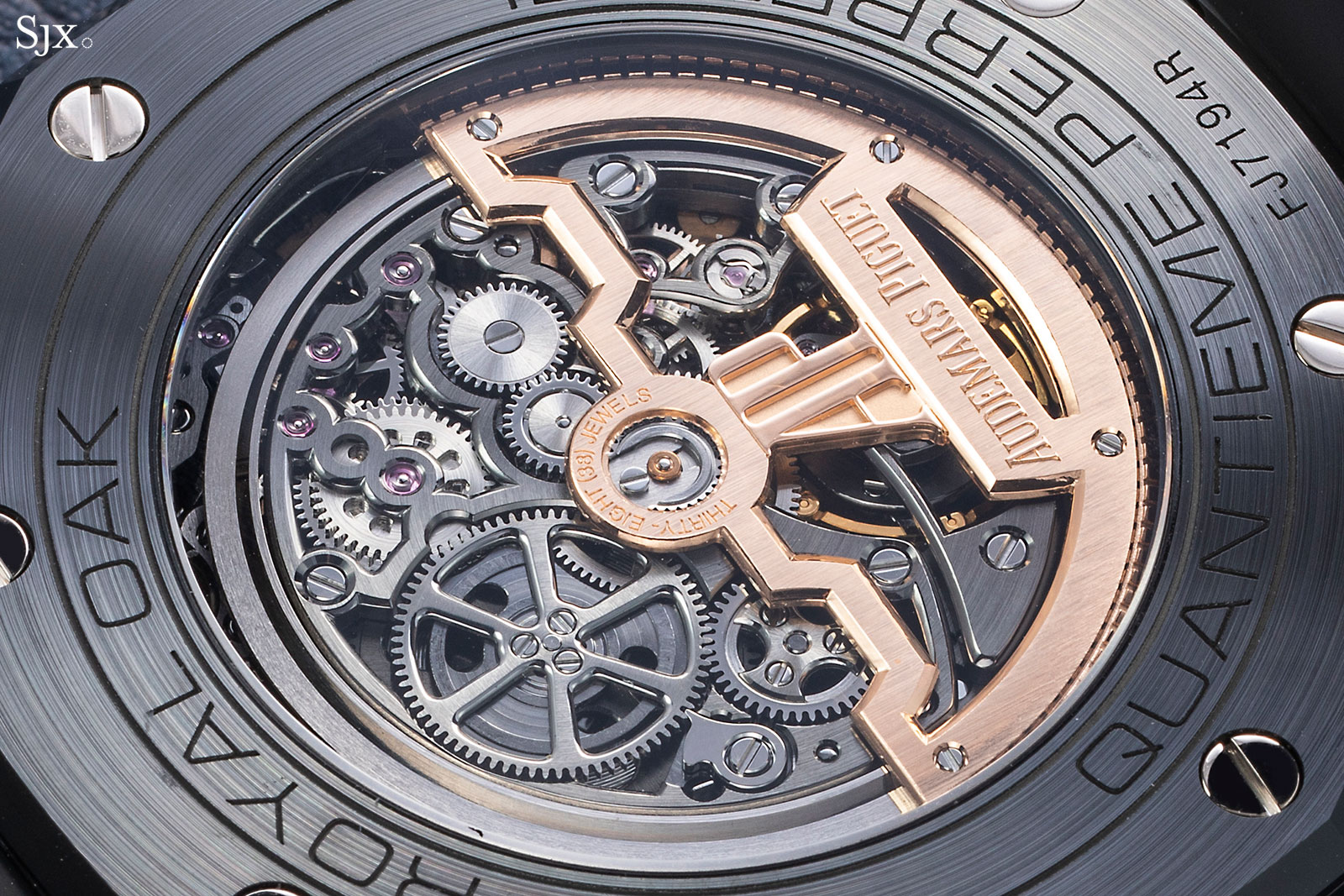
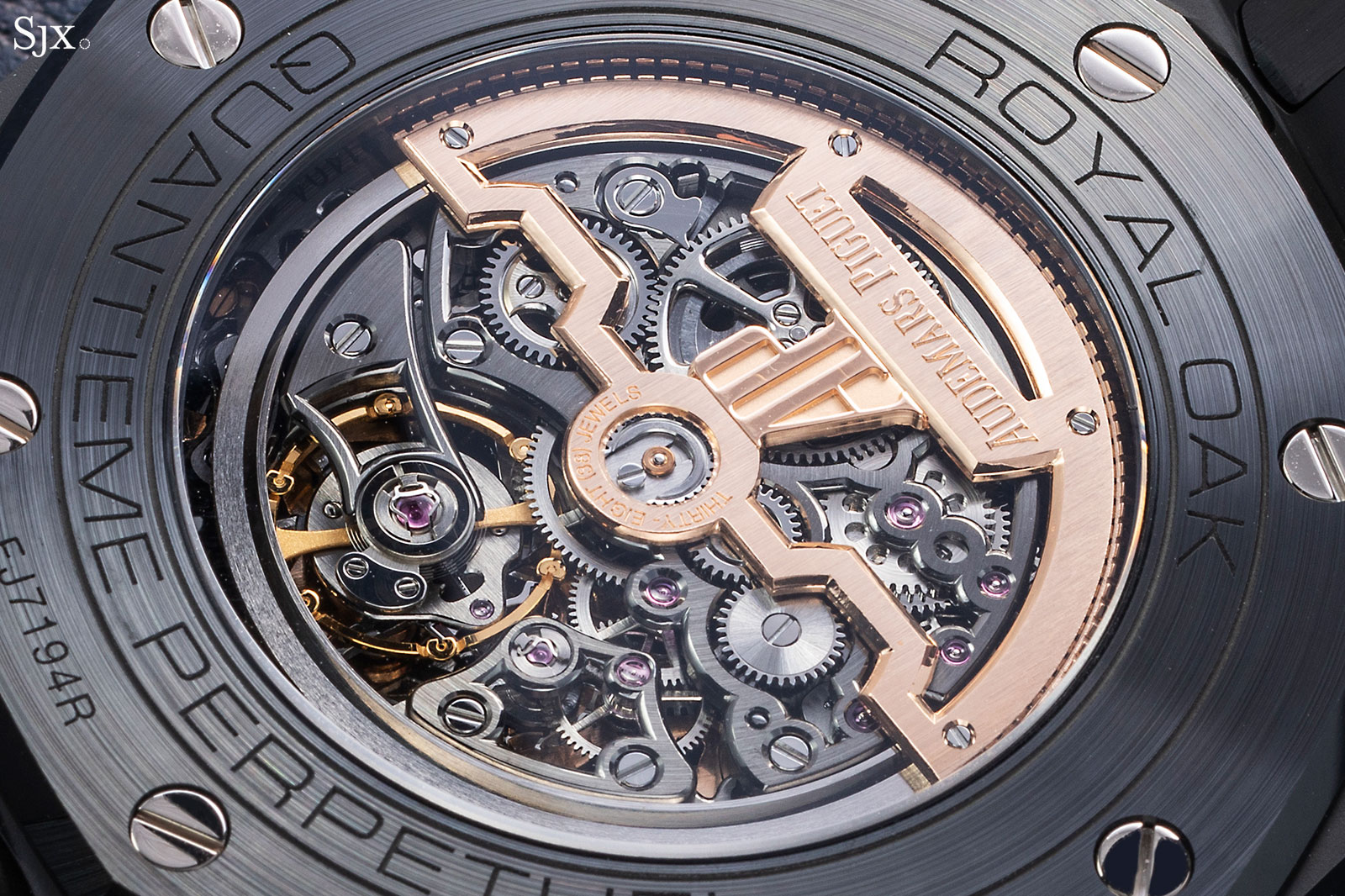
The balance wheel is free-sprung and has adjustable gold weights for regulation
One element found in the earlier generation of skeleton perpetual calendar movements that I miss is the elaborately chased rotor. The rotor used in the cal. 5135 is cleanly worked and engraved by machine; while it has the lustrous, hand-finished bevels found on the rest of the movement, it feels like it could do with a bit more artisanal craft.
More broadly, it would be a major plus to have a functional upgrade of the movement. Perhaps doing away with the calendar correctors (see nitpicking above), and lengthening the shortish power reserve.
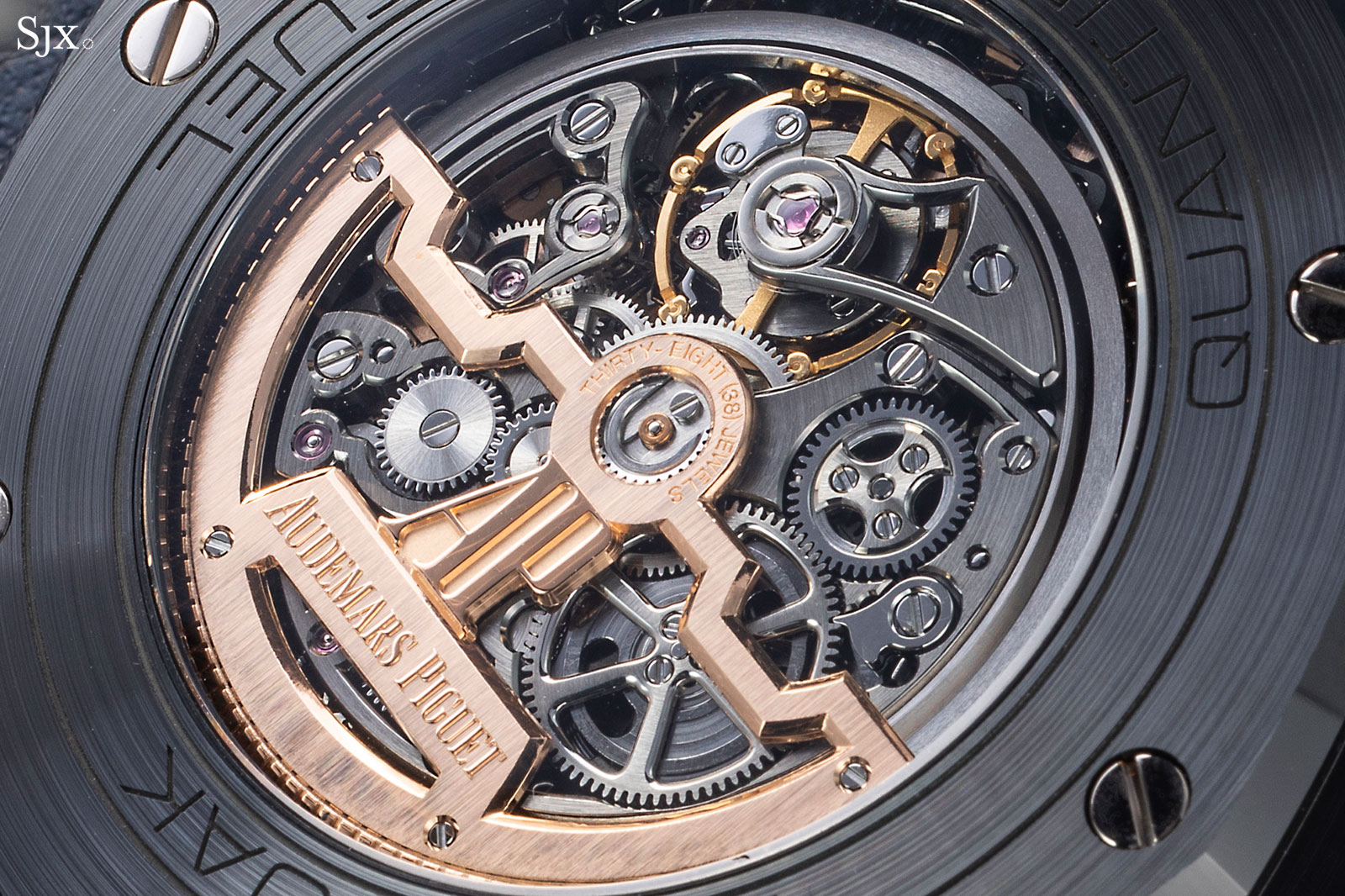
On the wrist
The watch has a beautiful presence on the wrist. Though it’s a largish watch, it is slim at just under 10mm high, and the black case gives it a smaller perceived size. It also wears well, although the titanium folding clasp (identical to that on the other models) feels like it could be thinner.
The intricacy and contrasting colours of the dial just jump out on the wrist. And because of that, this triumphs over the standard Royal Oak in black ceramic, which is too monochromatic for me, while the newer version in white ceramic is too bright and pearlescent. According to Mr Friedman, the skeleton perpetual movement will only be available in the black ceramic Royal Oak, at least for now. That’s more than enough.
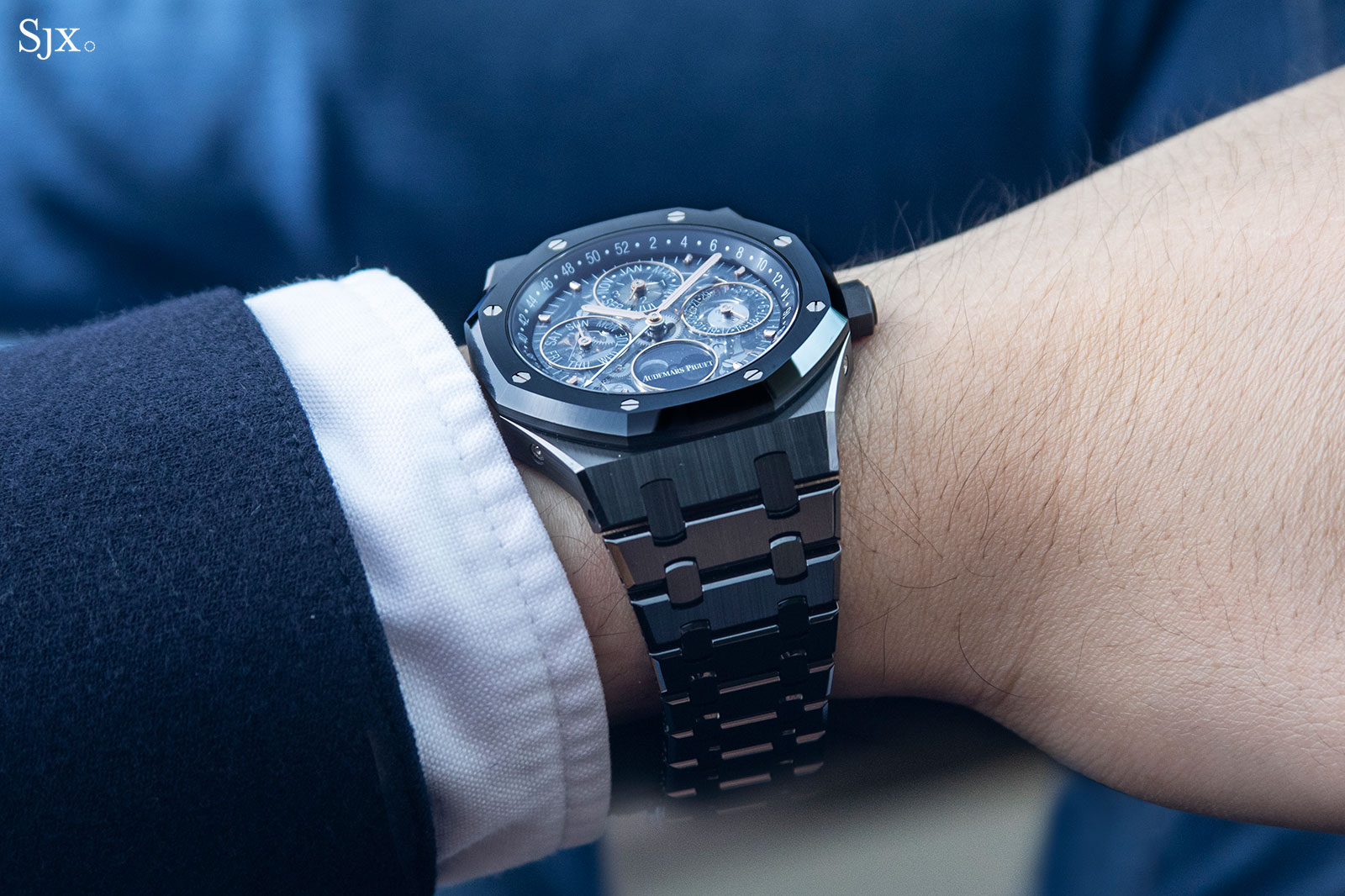
Concluding thoughts
It’s easy to like this watch, it is after all an iconic watch design. But it’s surprising how much better this is compared to the standard version in black (or white) ceramic, at least in my opinion.
The premium, at retail price, over the standard model is about 30%, which is well worth it, although there’s no doubt this will have a long, long wait list.
I only wish the movement would have been slightly upgraded, particularly in terms of calendar setting and power reserve. But for now, this is as good as it gets, and it’s very, very good.
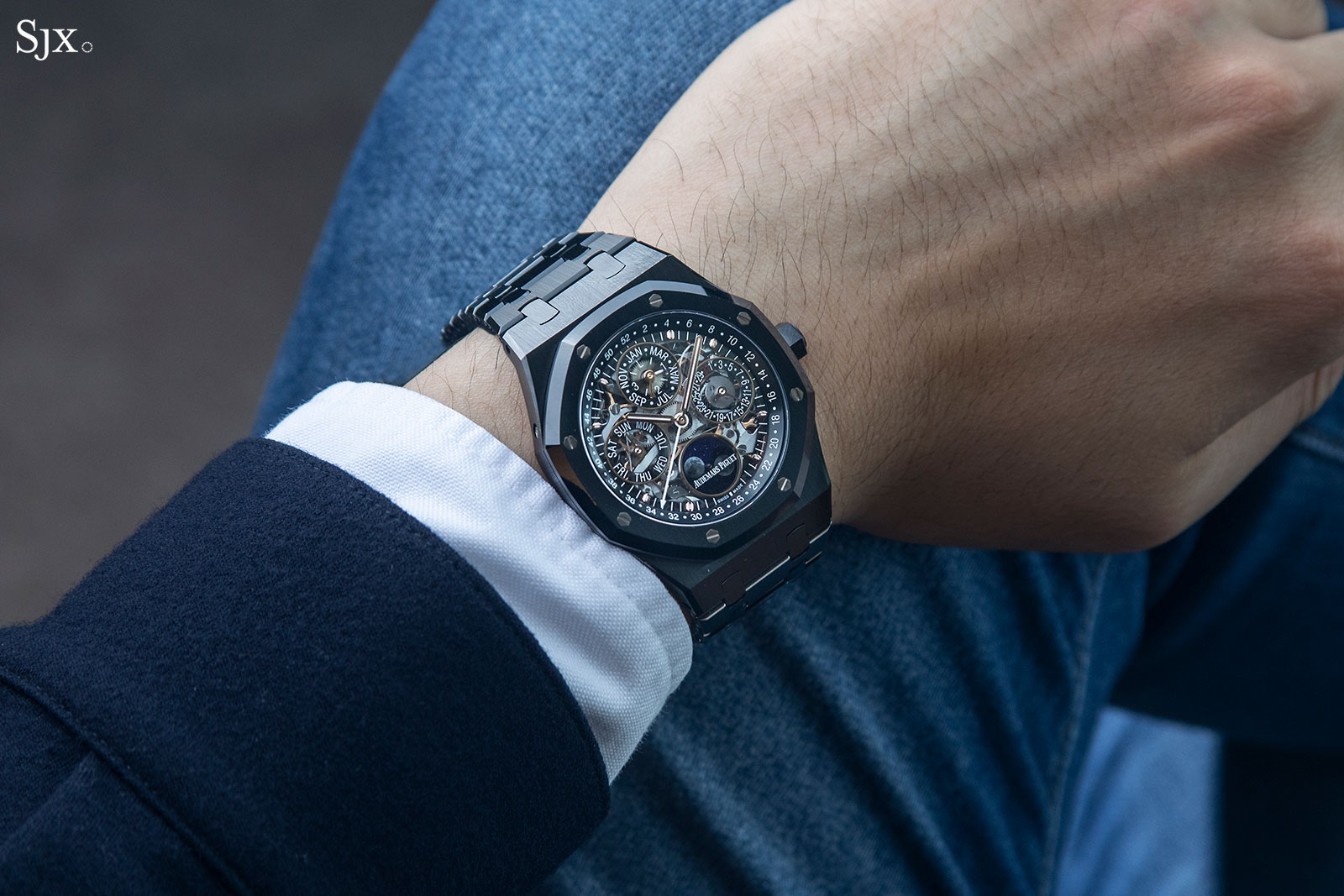
Key facts
Diameter: 41mm
Height: 9.9mm
Material: Black ceramic
Water resistance: 20m
Movement: Cal. 5135
Functions: Time, perpetual calendar with week of the year indication
Frequency: 19,800bph, or 2.75Hz
Winding: Automatic
Power reserve: 40 hours
Strap: Black ceramic bracelet
Price and availability
The Royal Oak Perpetual Calendar Openworked in black ceramic (ref. 26585CE.OO.1225CE.01) is priced at 130,000 Swiss francs without taxes. It’ll be available only at Audemars Piguet boutiques. For more, visit Audemarspiguet.com.
Correction October 2, 2019: Vacheron Constantin is the only other company using the JLC cal. 920, and not the only other company producing it, as stated in an earlier version of the article.
Back to top.
